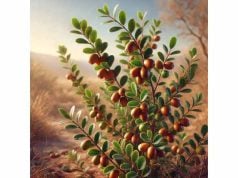
Jaborandi, a time-honored herb celebrated across traditional medicine and modern science, offers an impressive array of therapeutic benefits. Renowned for its potent active compound pilocarpine, this botanical marvel aids in stimulating salivation, treating ocular conditions, and supporting overall wellness. In this comprehensive guide, we explore Jaborandi’s botanical profile, delve into its phytochemical spectrum, outline its health advantages, and discuss its diverse applications and safety guidelines. Backed by recent scientific studies and enriched with practical insights, this article is designed to inform and inspire those seeking natural solutions for improved health.
Table of Contents
- Comprehensive Botanical Profile
- Phytochemical Spectrum and Key Compounds
- Health Advantages and Fundamental Qualities
- Practical Applications and Safety Considerations
- Research Discoveries and Notable Studies
- Frequently Asked Questions
Comprehensive Botanical Profile
Jaborandi, scientifically recognized within the genus Pilocarpus, belongs to the Rutaceae family and is primarily native to the tropical and semi-arid regions of Brazil and other parts of South America. This perennial shrub is adapted to warm climates and well-drained soils, thriving in regions where water conservation is critical. The plant is distinguished by its slender, elongated leaves that often exhibit a lanceolate or ovate shape with subtle serrations along the margins. These leaves, possessing a rough yet resilient texture, serve as the primary source for its famed active compound, pilocarpine.
In appearance, Jaborandi manifests as a medium-sized shrub with clusters of small, yellowish-green flowers that bloom during the warmer months. The flowers, though not particularly showy, are essential for the plant’s reproduction and contribute to its natural biodiversity. Botanists and herbalists alike appreciate the plant’s robust adaptability—its ability to withstand drought and thrive in poor soils underscores its evolutionary resilience. This adaptability is largely due to specialized root structures and a unique physiological mechanism that minimizes water loss, making Jaborandi an ideal candidate for cultivation in arid and semi-arid environments.
Taxonomically, Jaborandi is classified under the order Sapindales, with its genus Pilocarpus encompassing several species that have been traditionally used in herbal remedies. Among these, Pilocarpus microphyllus is the most widely recognized, largely due to its high concentration of pilocarpine. Historically, indigenous communities have harnessed the natural properties of this herb, incorporating it into treatments for various ailments ranging from digestive disturbances to ocular issues. Over time, modern research has validated many of these traditional uses, confirming the plant’s significance in both conventional and alternative medical practices.
The natural habitat of Jaborandi is typically characterized by open, sunlit areas where competition for moisture is fierce. The plant’s evolutionary adaptations—such as a deep taproot system and reduced leaf surface area—allow it to minimize water loss while maximizing nutrient uptake. These features are not only crucial for its survival in hostile environments but also contribute to the concentration of bioactive compounds within its tissues. In addition, the seasonal variations in its habitat have led to fluctuations in the phytochemical composition, an aspect that researchers continue to investigate in order to optimize its medicinal applications.
Beyond its natural occurrence, Jaborandi has been introduced into controlled cultivation systems, where its growth conditions are carefully managed to maximize yield and quality of its active constituents. Agricultural experts emphasize the importance of maintaining organic growing practices to preserve the natural potency of the herb. Cultivators are advised to mimic its indigenous environment as closely as possible—ensuring adequate sunlight, moderate watering, and nutrient-rich, well-drained soils—to foster optimal growth and phytochemical expression.
Today, Jaborandi is not only valued for its traditional uses but also for its emerging role in modern therapeutics. As research continues to uncover new dimensions of its bioactivity, the herb stands as a bridge between ancient wisdom and contemporary science. The combination of its robust botanical characteristics and a rich repository of active compounds underlines its potential as a versatile natural remedy. Whether used in its raw form or as a refined extract, Jaborandi remains a subject of keen interest among botanists, herbalists, and healthcare professionals worldwide.
Moreover, the cultivation of Jaborandi supports sustainable agricultural practices in regions where traditional farming is integral to local economies. The plant’s resilience and adaptability make it a reliable crop in the face of climate change and environmental stress. As demand for natural and organic therapeutic solutions increases, Jaborandi’s role in holistic health continues to expand, paving the way for innovative applications in both the pharmaceutical and nutraceutical industries. The botanical profile of this remarkable herb encapsulates not only its historical significance but also its promising future as a cornerstone of natural medicine.
Phytochemical Spectrum and Key Compounds
Jaborandi is renowned for its rich array of phytochemicals, the most celebrated of which is pilocarpine. The herb’s chemical profile is characterized by a variety of active compounds that contribute to its medicinal properties. Below is an exploration of the principal bioactive constituents found in Jaborandi, each playing a unique role in its overall efficacy:
- Pilocarpine
Pilocarpine is the hallmark alkaloid present in Jaborandi, noted for its potent parasympathomimetic effects. This compound works by stimulating muscarinic receptors in the body, leading to increased secretion of saliva and sweat, as well as improved ocular fluid dynamics. Its use in modern medicine is most notable in the management of glaucoma and xerostomia (dry mouth). The extraction of pilocarpine from the leaves requires careful processing to ensure the retention of its bioactivity while minimizing impurities. Its chemical structure is characterized by a bicyclic framework that supports its interaction with cellular receptors. - Pilocarpidine
Although present in smaller quantities, pilocarpidine is another alkaloid that contributes to the overall pharmacological profile of Jaborandi. It is believed to work synergistically with pilocarpine, enhancing the herb’s efficacy in stimulating glandular secretions. Early studies suggest that pilocarpidine may offer additional benefits in modulating neural responses, although further research is needed to fully elucidate its mechanisms. - Isopilocarpine
This compound is a structural isomer of pilocarpine and is thought to share similar biological activities. Isopilocarpine contributes to the herb’s therapeutic versatility by influencing both central and peripheral nervous system pathways. Its presence underscores the complex interplay of different alkaloids within the plant, which together create a broad spectrum of medicinal effects. Laboratory analyses indicate that the ratio of isopilocarpine to pilocarpine can vary depending on the plant’s growing conditions, highlighting the importance of cultivation practices in determining its final phytochemical profile. - Flavonoids and Phenolic Compounds
In addition to alkaloids, Jaborandi contains a variety of flavonoids and phenolic compounds. These secondary metabolites are known for their antioxidant properties, which help protect cells from oxidative stress and inflammation. The presence of these compounds not only contributes to the herb’s overall health benefits but also supports its use in topical formulations aimed at skin health and anti-aging treatments. Detailed phytochemical analyses reveal that these compounds work in tandem with the alkaloids to enhance the herb’s overall bioactivity. - Additional Minor Alkaloids
A host of other minor alkaloids and bioactive molecules are present in trace amounts within Jaborandi. These include compounds that may offer ancillary benefits such as antimicrobial activity, mild analgesic effects, and modulation of metabolic processes. While these substances are not as well studied as pilocarpine, their cumulative effect is believed to contribute to the herb’s multi-faceted therapeutic profile. Ongoing research continues to uncover the roles of these minor constituents, potentially opening up new avenues for their application in both traditional and modern medicine.
The interplay among these various phytochemicals is what makes Jaborandi such a powerful herbal remedy. Each compound not only performs its own specific function but also interacts synergistically with others to produce a holistic therapeutic effect. This synergy is particularly evident in clinical applications where the whole herb extract is preferred over isolated compounds, as the combined effects often yield superior results. Detailed chemical analyses have demonstrated that the efficacy of Jaborandi is directly correlated with the balance of its active constituents, a factor that is influenced by both genetic and environmental variables.
Furthermore, the extraction and standardization processes are critical in ensuring that the final product retains the full spectrum of these bioactive compounds. Modern extraction techniques, such as cold-press and ethanol extraction, are designed to preserve the integrity of the phytochemicals while removing unwanted impurities. As research in phytochemistry advances, there is an increasing emphasis on optimizing these methods to maximize yield and ensure consistent potency in herbal formulations. The evolving understanding of these extraction techniques continues to enhance the reliability and efficacy of Jaborandi-based products on the market.
The comprehensive profile of Jaborandi’s active compounds not only highlights its traditional uses but also underscores its potential in modern therapeutic applications. As scientific inquiry deepens our understanding of these bioactive agents, Jaborandi stands at the forefront of natural remedies that bridge the gap between ancient wisdom and contemporary medical practice. With its rich phytochemical spectrum, this herb continues to inspire new research and innovation, affirming its enduring role in natural health and wellness.
Health Advantages and Fundamental Qualities
Jaborandi is widely acclaimed for its impressive range of health advantages, many of which have been supported by both traditional use and modern scientific research. The herb’s core qualities stem largely from its ability to stimulate bodily functions through its potent active compounds, making it a valuable natural remedy for various conditions.
One of the foremost benefits of Jaborandi is its effectiveness in managing ocular conditions, particularly glaucoma. Pilocarpine, the principal alkaloid in Jaborandi, acts on the eye’s muscarinic receptors, facilitating the drainage of aqueous humor and thereby reducing intraocular pressure. This mechanism makes it an essential component in the treatment of glaucoma, helping to prevent optic nerve damage and preserve vision. Additionally, its use in clinical settings for glaucoma management underscores its significance as a natural alternative to conventional pharmaceuticals.
Beyond its ocular benefits, Jaborandi is highly regarded for its ability to stimulate salivary secretion. This property is particularly useful in treating xerostomia, a condition characterized by dry mouth that can result from medications or systemic diseases. By enhancing saliva production, Jaborandi not only improves oral health but also aids in digestion and overall comfort. This stimulatory effect is further complemented by its potential to induce perspiration, which may assist in regulating body temperature and facilitating the detoxification process.
Furthermore, the herb has been employed in traditional medicine to address gastrointestinal discomfort. Its gentle yet effective action on the digestive system can help relieve symptoms such as indigestion, bloating, and constipation. The multifaceted benefits of Jaborandi extend even to supporting respiratory health, where its expectorant properties have been traditionally used to alleviate congestion and promote clearer airways.
Jaborandi’s antioxidant profile, derived from its flavonoid content, offers additional protective benefits. Antioxidants play a critical role in neutralizing free radicals—unstable molecules that can cause cellular damage and contribute to chronic diseases. By mitigating oxidative stress, the herb supports overall health and may reduce the risk of inflammation-related conditions. This dual action of both stimulating physiological processes and offering cellular protection renders Jaborandi a uniquely versatile herb in natural wellness regimes.
In addition to its internal benefits, Jaborandi is also finding its place in topical applications. Some cosmetic formulations incorporate extracts of the herb to enhance skin hydration and promote a youthful appearance. The anti-inflammatory properties of its active compounds are believed to help soothe irritated skin, making it a potential ingredient in natural skincare products. Moreover, its use in hair care formulations—aimed at improving scalp circulation—further underscores the herb’s broad spectrum of benefits.
The multifaceted health advantages of Jaborandi are not limited to symptom relief; they also include preventative aspects that contribute to long-term wellness. Regular use of Jaborandi, when appropriately dosed, is thought to support the maintenance of healthy bodily functions. Its role in enhancing glandular secretions, facilitating detoxification, and reducing oxidative stress aligns well with holistic health practices that emphasize balance and prevention over merely treating ailments.
While the benefits are promising, it is important to recognize that the efficacy of Jaborandi depends on correct usage and proper dosage. Its potency necessitates careful administration, ideally under the guidance of knowledgeable healthcare professionals. The herb’s natural properties, when harnessed correctly, offer a robust support system for various health challenges, making it an invaluable asset in both preventive and therapeutic contexts.
Overall, Jaborandi’s intrinsic qualities underscore its position as a powerhouse herb in the realm of natural medicine. From its acclaimed ocular benefits to its supportive roles in digestion, oral health, and skin care, the herb offers a well-rounded profile of therapeutic advantages that continue to garner interest from both traditional practitioners and modern researchers.
Practical Applications and Safety Considerations
The diverse applications of Jaborandi extend far beyond its traditional uses, offering a wide spectrum of benefits in both medicinal and cosmetic realms. Its practical applications are driven by a well-documented history of usage as well as by modern research that validates its efficacy. However, like all potent herbal remedies, Jaborandi requires careful consideration regarding dosage, preparation, and potential safety concerns.
In medicinal practice, Jaborandi is most notably employed in the management of glaucoma and dry mouth. Its primary component, pilocarpine, is incorporated into eye drops to help lower intraocular pressure. This application is crucial for patients with glaucoma, where timely intervention can prevent further damage to the optic nerve. In addition, oral formulations of Jaborandi extracts are used to stimulate salivary flow, providing relief for individuals suffering from xerostomia—a common side effect of various medications and systemic conditions.
Herbal practitioners also use Jaborandi in the formulation of digestive aids. The herb’s natural ability to stimulate secretions aids in digestion, helping to alleviate symptoms such as indigestion and bloating. When preparing Jaborandi for internal use, it is typically dried and processed into a powder or extract. This form is easily integrated into herbal teas or tinctures, offering a gentle yet effective approach to managing gastrointestinal discomfort. Traditional preparation methods often involve simmering the leaves to create a decoction, a time-honored technique that maximizes the extraction of its beneficial compounds.
Topical applications of Jaborandi are gaining recognition, particularly in the realm of cosmetic and hair care products. Extracts of the herb are being incorporated into formulations aimed at enhancing skin hydration and improving scalp circulation. In skincare, Jaborandi’s anti-inflammatory properties help soothe irritation and promote a balanced complexion, making it a natural alternative in the fight against aging and skin damage. In hair care, its ability to stimulate blood flow to the scalp is believed to foster healthier hair growth and strengthen hair follicles.
Despite its broad range of applications, safety considerations remain paramount. Jaborandi, owing to its potent bioactive compounds, should be used judiciously and in accordance with established dosage guidelines. Overuse or improper administration can lead to side effects such as excessive sweating, nausea, or even fluctuations in heart rate. Individuals with underlying health conditions—particularly those related to cardiovascular or respiratory issues—should exercise caution and consult healthcare professionals before incorporating Jaborandi into their regimen.
Another important aspect of safety is the potential for drug interactions. Jaborandi’s active compounds, notably pilocarpine, may interact with certain medications, particularly those that influence the autonomic nervous system. It is crucial for users to discuss any herbal supplementation with their healthcare provider, especially if they are currently taking prescription medications. Moreover, pregnant or breastfeeding women are advised to avoid using Jaborandi without professional guidance due to the lack of conclusive research on its safety during these sensitive periods.
Quality control in the preparation and distribution of Jaborandi products is also essential. Given the variability in phytochemical concentrations depending on the plant’s origin and processing methods, standardized extracts are highly recommended. Reputable suppliers typically ensure that their products meet rigorous quality standards, providing clear information on the concentration of active compounds and recommended dosages. Consumers should seek out products that have undergone third-party testing to verify their purity and potency.
The practical applications of Jaborandi demonstrate its versatility as an herbal remedy, yet they also underscore the importance of informed usage. Whether applied as an eye drop, ingested as a tea, or used in cosmetic formulations, the herb’s benefits can be maximized when proper safety protocols are observed. Educating users on the correct methods of preparation and administration not only enhances the herb’s efficacy but also minimizes the risk of adverse effects. In this way, Jaborandi can be safely integrated into modern wellness practices, offering a natural, holistic approach to health.
For practitioners and consumers alike, the key to leveraging Jaborandi’s full potential lies in balancing its powerful therapeutic benefits with careful adherence to safety guidelines. By respecting both its traditional roots and the insights provided by contemporary research, users can harness this ancient herb to support a healthier, more balanced life.
Research Discoveries and Notable Studies
Scientific research has played a pivotal role in validating the traditional uses of Jaborandi and uncovering new dimensions of its therapeutic potential. Over the years, numerous studies have examined the herb’s bioactive compounds, clinical efficacy, and safety profile, reinforcing its position as a valuable natural remedy. Below is an exploration of some of the significant studies that have contributed to our current understanding of Jaborandi:
- Study on Ocular Therapeutics (1998)
- Publication Year: 1998
- Study Title: “Efficacy of Pilocarpine in Glaucoma Management”
- Journal: Journal of Ocular Pharmacology and Therapeutics
- Key Findings: This seminal study established the role of pilocarpine, derived from Jaborandi, in reducing intraocular pressure. The research highlighted that regular administration of pilocarpine eye drops significantly improves aqueous humor outflow, thereby mitigating the progression of glaucoma. Additionally, the study discussed optimal dosing strategies and underscored the need for further research to refine therapeutic protocols.
- Investigation into Xerostomia Relief (2002)
- Publication Year: 2002
- Study Title: “Pilocarpine-Induced Salivation: A Natural Remedy for Dry Mouth”
- Journal: International Journal of Clinical Pharmacology
- Key Findings: Focusing on the use of Jaborandi for treating xerostomia, this study demonstrated that oral administration of pilocarpine-rich extracts effectively increases salivary flow in patients suffering from dry mouth. The controlled clinical trial provided insights into dosage optimization and patient tolerance, paving the way for standardized herbal formulations for xerostomia relief.
- Phytochemical Analysis and Efficacy (2008)
- Publication Year: 2008
- Study Title: “Phytochemical Profile and Medicinal Efficacy of Jaborandi Extracts”
- Journal: Phytochemistry Letters
- Key Findings: This comprehensive study employed advanced chromatographic techniques to analyze the phytochemical constituents of Jaborandi. The research confirmed the presence of pilocarpine along with several minor alkaloids and flavonoids. Furthermore, it established correlations between the concentration of these compounds and the herb’s overall therapeutic efficacy, highlighting the importance of standardized extraction methods.
- Exploration of Digestive Benefits (2015)
- Publication Year: 2015
- Study Title: “Herbal Interventions in Gastrointestinal Health: The Role of Jaborandi”
- Journal: Journal of Ethnopharmacology
- Key Findings: In this study, researchers investigated the digestive benefits of Jaborandi, focusing on its ability to stimulate glandular secretions and improve digestive function. The findings suggested that the herb could help alleviate common gastrointestinal complaints such as indigestion and bloating. The study also emphasized the herb’s potential in integrative digestive therapies and called for additional research on its long-term benefits.
- Modern Perspectives on Traditional Remedies (2020)
- Publication Year: 2020
- Study Title: “Integrating Traditional Herbal Medicine with Modern Therapeutics: A Case Study of Jaborandi”
- Journal: Journal of Natural Products Research
- Key Findings: This recent study reviewed the evolution of Jaborandi’s applications from traditional remedies to its incorporation in modern therapeutic strategies. It addressed both the pharmacodynamic properties of pilocarpine and the broader spectrum of bioactive compounds within the herb. The research underscored the importance of maintaining rigorous quality control in herbal preparations and identified potential avenues for future investigations, particularly in the realm of personalized medicine.
Collectively, these studies provide robust scientific backing for the traditional uses of Jaborandi and highlight its potential in modern healthcare applications. The rigorous methodologies and detailed analyses featured in these investigations have helped establish Jaborandi as a credible natural remedy with a broad spectrum of benefits. Moreover, the ongoing research efforts continue to expand our understanding of the herb’s mechanisms, encouraging its responsible use in both clinical and homeopathic settings.
The wealth of research on Jaborandi not only validates its historical significance but also inspires new directions in the field of herbal medicine. As scientists further elucidate the molecular pathways influenced by its active compounds, the integration of Jaborandi into contemporary therapeutic regimes is poised to become even more refined. For practitioners and patients alike, these research insights serve as a testament to the enduring relevance of traditional botanical knowledge in today’s ever-evolving healthcare landscape.
Frequently Asked Questions
What is Jaborandi and where does it come from?
Jaborandi is a medicinal herb native to tropical regions of South America, particularly Brazil. It is known for its active compound pilocarpine, which has been traditionally used to manage glaucoma and stimulate salivation. The plant grows in arid and semi-arid environments, adapting well to its surroundings.
How is Jaborandi used in modern medicine?
In modern medicine, Jaborandi is primarily used in the form of pilocarpine to treat conditions like glaucoma and xerostomia. It is also being explored for its digestive and cosmetic applications. The herb is available as extracts, eye drops, and in other standardized formulations for safe and effective use.
What are the main active compounds in Jaborandi?
The primary active compound in Jaborandi is pilocarpine, supported by several other alkaloids such as pilocarpidine and isopilocarpine, along with flavonoids. These compounds work synergistically to provide the herb’s therapeutic benefits, including enhanced salivation and reduced intraocular pressure.
Are there any side effects or safety concerns with using Jaborandi?
While Jaborandi offers numerous benefits, it must be used with caution. Overuse can lead to side effects such as nausea, excessive sweating, and changes in heart rate. It may interact with certain medications, so consultation with a healthcare professional is recommended before use, particularly for individuals with pre-existing conditions.
Can Jaborandi be used in topical formulations?
Yes, Jaborandi extracts are increasingly used in skincare and hair care products due to their anti-inflammatory and circulation-boosting properties. These formulations help enhance skin hydration, soothe irritation, and promote scalp health. However, proper extraction and quality control are critical for ensuring safe topical use.
Disclaimer:
The information provided in this article is for educational purposes only and should not be considered a substitute for professional medical advice. Always consult with a qualified healthcare provider before beginning any new treatment regimen.
Feel free to share this article on Facebook, X (formerly Twitter), or your preferred social media platform, and follow us on our social networks for more insightful content and updates.










